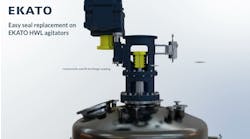Doing something at a time that will avoid notice is an old ruse. A steel mill I once worked at in Turkey regularly rumbled their coke beds at 4 am. Another company I worked at scheduled startups using new packing during the evening when blowing rust and acid out of the system was less obvious.
Other, not nefarious, activities also benefit from being done at odd hours. For instance, conducting walkdowns, i.e., physically inspecting how a process and equipment are running, between shifts and at unusual times is the best time to catch irregularities in operations.
I strongly believe walkdowns are crucial to keeping on top of maintenance and operations. Such inspections shouldn’t be on a schedule or deemed the private turf of a specific department. Typically, I do two-to-three walkdowns a week, taking a total of about four-to-six hours. I carry a flashlight and a smartphone, and use a photo editor and video software. Naturally, some people at the plant won’t like recurring reminders about ongoing problems. So, the person doing the walkdowns likely will need a thick skin — and may lose a few friends.
The reaction to a request to conduct walkdowns can be telling. If the idea doesn’t get support, I suggest looking for another job. Being told walkdowns are limited to a select few indicates, to me at least, information is siloed for political reasons.
[pullquote]
Assuming you get the support you need, what should you do on a walkdown? First, have patience — listen for unusual noises and look for things out of place. I stare at equipment for about a minute and take in the whole scene. Watch what people are doing or not doing. Look up and down. Then, start taking pictures and videos. Videos not only can show movement, such as steam escaping from a failed trap or a swaying unsupported pipe, but also are useful for capturing sounds, like a bearing screaming.
Lighting is important. Typically, I will take photos in room light, first from a distance and then close up. If the photo is grainy, I put the flashlight just outside the frame and reshoot, making sure the photo isn’t over-exposed.
Take two shots of important views. The camera may blur one of them. Anchor your wrist on a non-moving wall or something rigid whenever you can. Move around: take shots from the sides, top or even bottom if they clarify the problem. In addition, snap photos of the surroundings, to help later in identifying the location. Ensure the smartphone’s clock is set to the correct time; you need to record the actual time a shot was taken. Don’t be shy about photographing things the plant got right.
Pictures alone aren’t enough. While a picture may say a thousand words, a video paints it across the sky! Nothing shows the problems with a rotating dryer or wash bed like a video. I climbed to the top of a plant in the winter to show all the steam wasted; I zoomed in, resting the smartphone on a handrail to brace it. Hit the pause button and then move the focus to another area. The first frame in the video should center on the equipment you wish to identify; I hold that shot for about three seconds. Then, pause, and move to whatever got your attention. You may have to change position to show the problem in a tighter frame or from a different angle. Use a flashlight if the photo you took earlier appears grainy.
I eventually transfer the pictures and videos to an external drive to free up space on the smart phone and provide long-term storage.
So, what should you look for? Here’s a short list: 1) steam traps with a continuous flow of steam; 2) poorly supported pipe; 3) equipment vibration and noise; 4) filled sewers; 5) leaks; 6) unplugged valves; 7) broken grounding; 8) unsafe or unproductive practices; 9) poor housekeeping; 10) changes in meter readings; 11) damaged equipment; 12) poor repairs; 13) mislabeled equipment; 14) corrosion; 15) torn-down equipment — never pass up a chance to look at the guts; 16) open manways; 17) impaired infrastructure, e.g., steel, concrete, etc.; and 18) damaged electrical boxes and conduit.
I’ve worked at companies that required every employee to perform a walkdown. I consider that a great idea.


